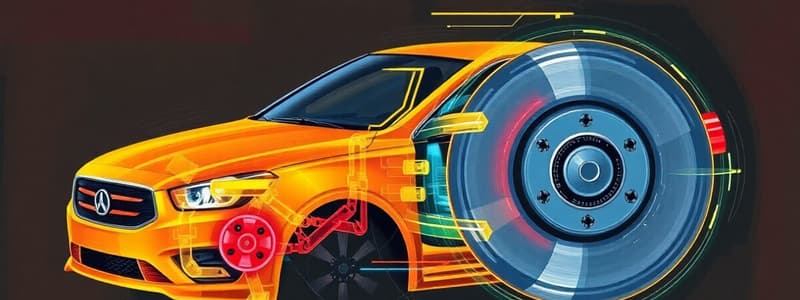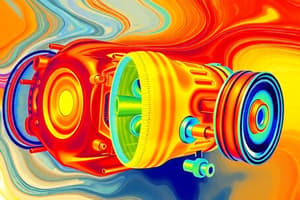Podcast
Questions and Answers
VDC enhances a vehicle's maximum performance capabilities beyond its inherent limits.
VDC enhances a vehicle's maximum performance capabilities beyond its inherent limits.
False (B)
The VDC system only uses data from the steering wheel angle to correct sideslip.
The VDC system only uses data from the steering wheel angle to correct sideslip.
False (B)
The VDC system is ineffective at very low vehicle speeds.
The VDC system is ineffective at very low vehicle speeds.
False (B)
When the VDC buzzer sounds, it indicates the system is functioning normally far from the vehicle's performance limits.
When the VDC buzzer sounds, it indicates the system is functioning normally far from the vehicle's performance limits.
The primary function of ABS is to prevent wheel lock during braking, especially on slippery surfaces.
The primary function of ABS is to prevent wheel lock during braking, especially on slippery surfaces.
VDC primarily relies on enhancing tire grip to improve vehicle stability.
VDC primarily relies on enhancing tire grip to improve vehicle stability.
ABS allows the driver to maintain steering control during hard braking.
ABS allows the driver to maintain steering control during hard braking.
VDC is only effective at high speeds and during emergency maneuvers.
VDC is only effective at high speeds and during emergency maneuvers.
ABS works by rapidly and repeatedly applying and releasing the brakes.
ABS works by rapidly and repeatedly applying and releasing the brakes.
VDC completely eliminates the risk of accidents, regardless of driving conditions.
VDC completely eliminates the risk of accidents, regardless of driving conditions.
ABS and TCS are distinct systems designed to work independently; they do not interact to enhance vehicle stability.
ABS and TCS are distinct systems designed to work independently; they do not interact to enhance vehicle stability.
The activation of VDC is always silent and has no auditory or visual warnings.
The activation of VDC is always silent and has no auditory or visual warnings.
VDC's braking force is applied uniformly to all four wheels at all times.
VDC's braking force is applied uniformly to all four wheels at all times.
ABS can only be used on snow-covered roads.
ABS can only be used on snow-covered roads.
A primary function of VDC is preventing spinning during lane changes on slippery road surfaces through engine output regulation and brake force control.
A primary function of VDC is preventing spinning during lane changes on slippery road surfaces through engine output regulation and brake force control.
ABS is designed to be used primarily when making gradual stops and not in situations requiring sudden braking.
ABS is designed to be used primarily when making gradual stops and not in situations requiring sudden braking.
VDC is designed to eliminate the need for driver caution in adverse driving conditions.
VDC is designed to eliminate the need for driver caution in adverse driving conditions.
ABS only benefits the car's braking performance and has very little impact on the car's ability to steer during braking.
ABS only benefits the car's braking performance and has very little impact on the car's ability to steer during braking.
VDC ensures total safety in all driving conditions, irrespective of road surface or driver behavior.
VDC ensures total safety in all driving conditions, irrespective of road surface or driver behavior.
The primary role of ABS is to enhance tire grip and reduce the stopping distance of the vehicle when braking.
The primary role of ABS is to enhance tire grip and reduce the stopping distance of the vehicle when braking.
Flashcards
Vehicle Dynamics Control (VDC)
Vehicle Dynamics Control (VDC)
A system that enhances vehicle stability by automatically correcting a vehicle’s lateral behavior based on detection of sideslip using various sensors.
How VDC Prevents Spinning
How VDC Prevents Spinning
VDC regulates engine output and controls braking force at all four wheels to reduce oversteer and maintain driving stability.
Anti-lock Braking System (ABS)
Anti-lock Braking System (ABS)
A system that electronically controls brake fluid pressure to prevent wheels from locking during sudden braking, improving stability and steering.
VDC Limitations
VDC Limitations
Signup and view all the flashcards
VDC Activation Warning
VDC Activation Warning
Signup and view all the flashcards
Study Notes
- VDC (Vehicle Dynamics Control) enhances driving stability by automatically correcting a vehicle’s lateral behavior based on sideslip detection.
- VDC utilizes various sensors to monitor the driver’s steering and braking, as well as the vehicle’s dynamic state.
- The VDC system enhances vehicle stability during evasive maneuvers and assures steering control and braking performance.
- VDC is effective even at low speeds.
- VDC does not increase friction between tires and road surfaces, nor does it enhance a vehicle’s maximum performance.
- Activation of VDC is indicated by the VDC buzzer or slip indicator lamp, signaling that the vehicle is near its performance limits, requiring the driver to take precautions.
- VDC prevents spinning during lane changes on slippery roads by regulating engine output.
- VDC controls the braking force at all four wheels to reduce oversteer and maintain driving stability.
ABS (Anti-lock Braking System)
- ABS electronically controls brake fluid pressure to prevent wheel lock during sudden braking on slippery surfaces.
- ABS improves a vehicle’s stability in braking.
- ABS makes steering easier to avoid obstacles.
Studying That Suits You
Use AI to generate personalized quizzes and flashcards to suit your learning preferences.




